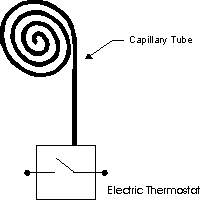Dave's Place
Electric Thermostat

You should read the section on electric safety before attempting any repairs.
All the information below pertaining to electric thermostats also pertain to the electric side of a Combination Thermostat.
The electric thermostat is merely an on/off switch controlled by temperature through the capillary tube. The capillary tube is a hollow, sealed tube filled with a gas that expands and contracts with changes in temperature. This movement of the gas moves a bellows, which in turn activates a spring loaded on/off switch.
The end of the capillary tube is positioned at a specific point on the evaporator (usually the fins) of the lower box. When replacing an electric thermostat be sure to position the capillary tube in the same manner as the old one. Failure to do so may cause inadequate contact, resulting in over cooling.
Testing the electric thermostat is a matter of making sure that electricity passes through the thermostat when it is supposed to, and doesn't when it's not. If the thermostat is disconnected from the rest of the electrical system, you can test for continuity with an ohm meter. If power is present, you can test for voltage going into the thermostat and back out with a volt meter (120 or 12 volt depending on the application). Remember the switch is controlled by the temperature of the box, so take the temperature into consideration when testing. Sometimes it may be convenient to by pass the thermostat by connecting the two wires to the thermostat together.
There usually is a small adjustment screw on the electric thermostat that sets the temperature range. For example, if the range is set at 30 to 40 degrees, you could change it to 32 to 42 degrees. Normally, you shouldn't touch this screw. If you do, do so in half turns and wait for the results. Usually, turning the screw in (clockwise) lowers the temperature range.
RV Refrigerator Home
This RV refridgerator information was originally located on rvmobile.comRV Mobile Inc. 11715 HWY 99, Everett, WA 98204
The owner of RV Mobile Inc. apparently suffered a heart attack and the original website was shut down.
It has been reposted here to preserve this wealth of information RV refridgerator information.